Moose photos

20, 3020+ Ft. Mt. Denali, Bull, and Cow Moose In Autumn Tundra Grasses, Denali National Park, Alaska (Patrick J. Endres / AlaskaPhotoGraphics.com)
Alaska Moose
I have an extensive collection of moose photos taken in all seasons and from many regions throughout Alaska. I’ve gathered a few images to illustrate some natural history information. More pictures can be found through the links or keyword searches above. The moose photos here are available to license as commercial stock photography or purchase as fine art prints for your home or office.
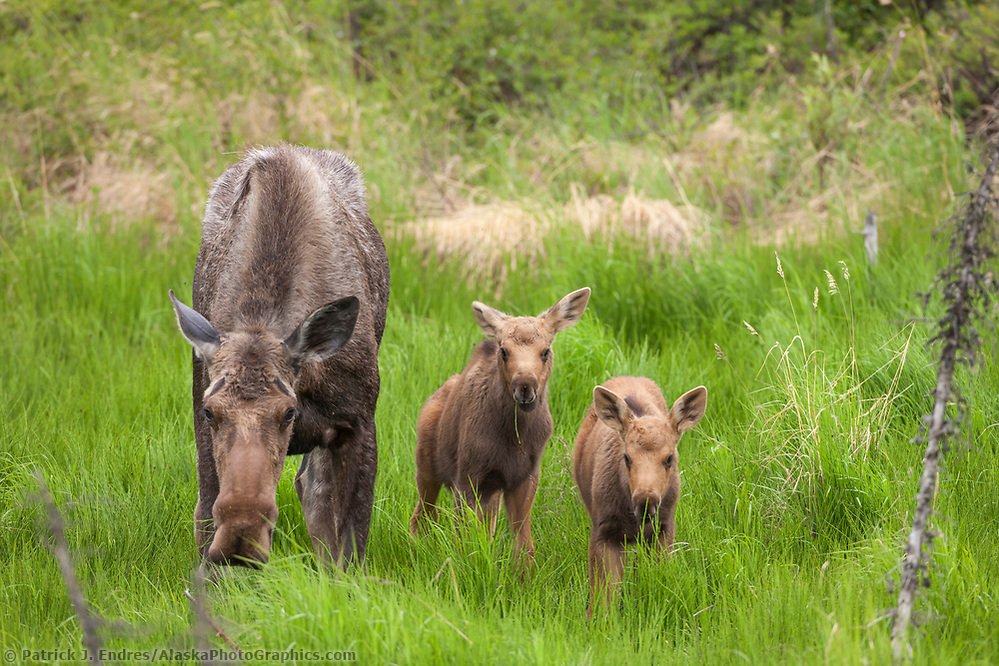
Cow moose with two spring calves feed on grasses in the Arctic, Alaska. (Patrick J Endres / AlaskaPhotoGraphics.com)
Moose (Alces alces)
The towering, unique, and gangly-looking moose is one of Alaska’s favorite animals. They roam much of the state, inhabiting the boreal forest and taiga regions throughout Alaska. While their long, slender legs that suspend a huge body may appear clumsy, they move with surprising agility across tundra wetlands and spruce forests.
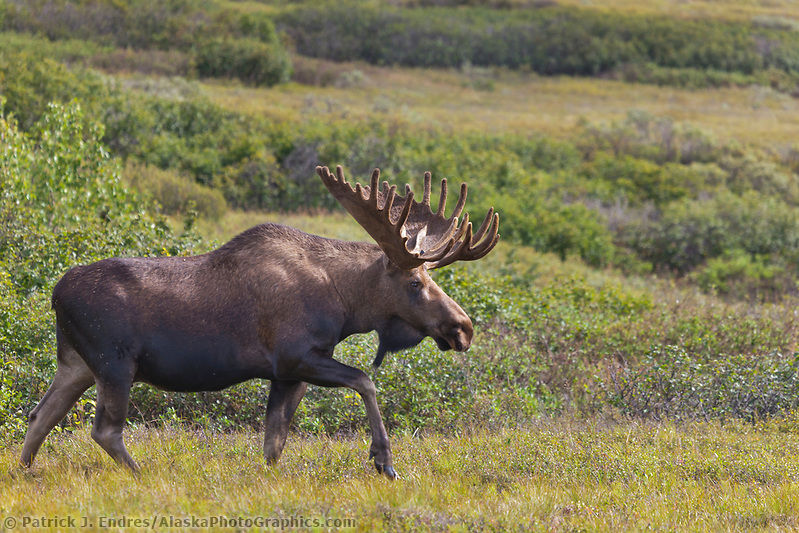
Large bull moose in velvet antlers walks across the open tundra vegetation of dwarf birch, willows, and alders in Denali National Park, interior, Alaska. (Patrick J. Endres / AlaskaPhotoGraphics.com)
Size
Moose are the largest member of the deer family, and mature bulls can reach weights of 1200-1600 pounds. Cows, on average, weigh between 800-1300 pounds. They are light-to-dark brown, depending on the age and season. The odd-looking “beard-like” shape under the chin is called a “bell” or dewlap.
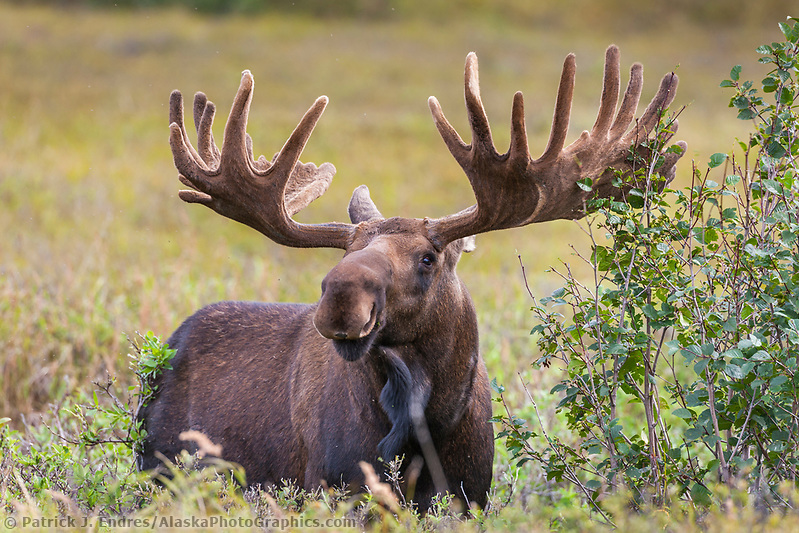
Large bull moose in velvet antlers feed on the summer tundra vegetation of willows and alders in Denali National Park, interior, Alaska. (Patrick J. Endres / AlaskaPhotoGraphics.com)
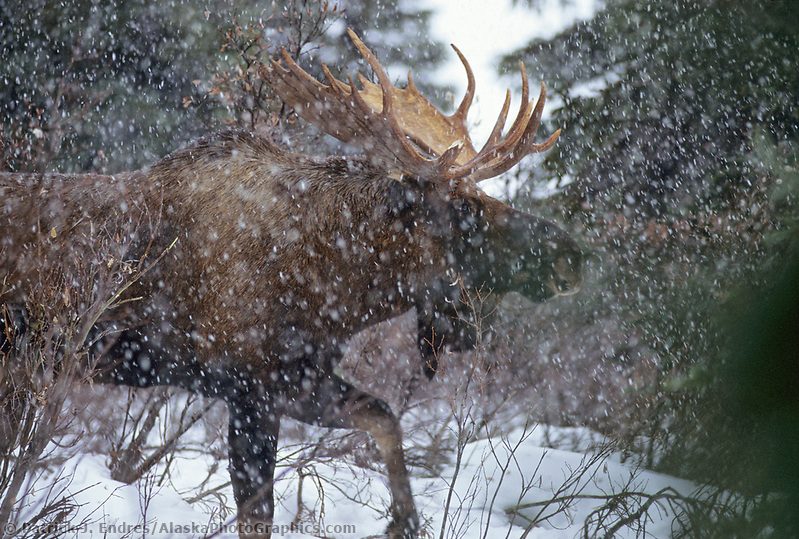
Bull moose in a winter snowstorm. Denali National Park, Alaska. (Patrick J. Endres / AlaskaPhotoGraphics.com)
Cow moose and calves
Cow moose generally breed at 2-1/2 years of age and typically give birth to twin calves from mid-May to early June after a gestation period of about 230 days. The hair of newborn calves is generally red-brown to a rust color. They are considered adorable! Newly born calves weigh between 28 to 35 pounds and proliferate. In the first weeks following birth, they stay incredibly close to their mother, and cows can be aggressive and sometimes ferocious in protecting their young. Calves stay with the cow for about a year.
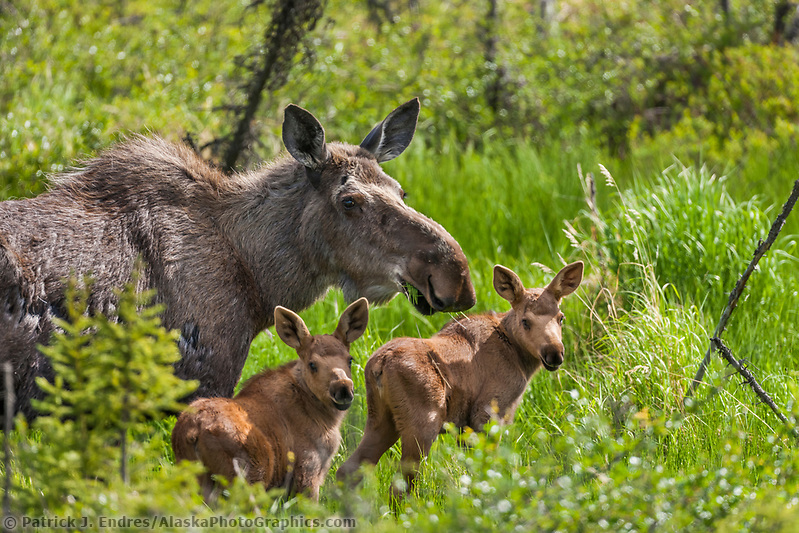
Cow moose and twin calves feed on spring grasses Arctic, Alaska. (Patrick J Endres / AlaskaPhotoGraphics.com)
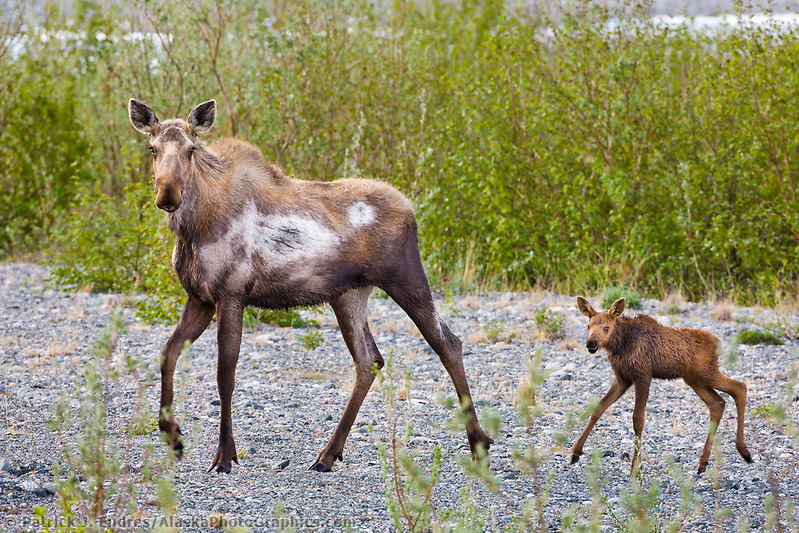
Cow and spring calf moose, Interior, Alaska. (Patrick J. Endres / AlaskaPhotoGraphics.com)
Predation
Moose are preyed upon by wolves, black bears, and brown bears. While much predation occurs on young moose calves, brown bears can prey on calves and adults throughout the summer and autumn seasons. Wolves kill moose throughout the entire year by hunting them strategically as a pack, surrounding the moose, and working cooperatively. Some of the most dramatic moose photos I’ve taken were when I watched a group of five wolves surround a cow moose and calf in a small tundra pond in early June in Denali National Park. In approximately 20 minutes, despite the ferocious attempts by the cow to fend off the wolves, they eventually killed the calf. Experiences like this are not easy to come by, and witnessing that natural history moment, as difficult as it was to watch, is not likely to be repeated by me. Predation limits the growth of many moose populations in Alaska. Deep-crusted snow and other weather events can contribute to food restriction and result in malnutrition and subsequent death.
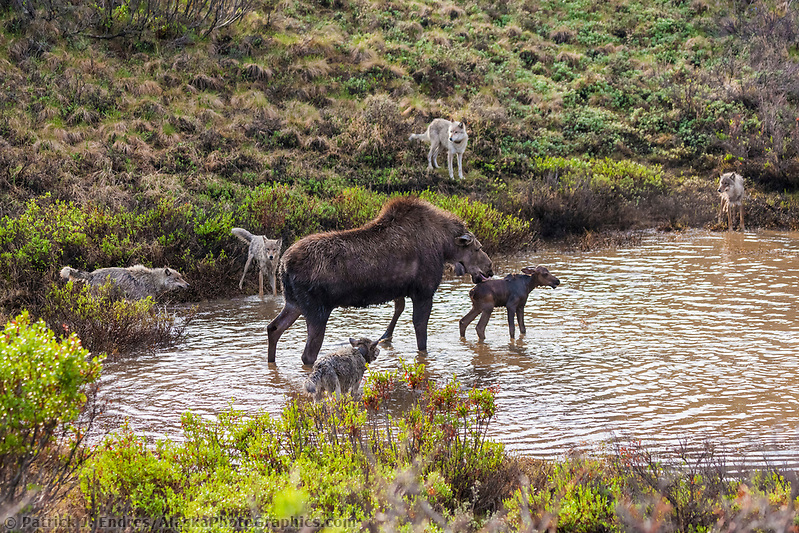
Cow moose defends her newly born calf from the Grant Creek wolf pack, who attack them in a small tundra pond, Denali National Park. In the end, the wolves got the baby moose. (Patrick J Endres / AlaskaPhotoGraphics.com)
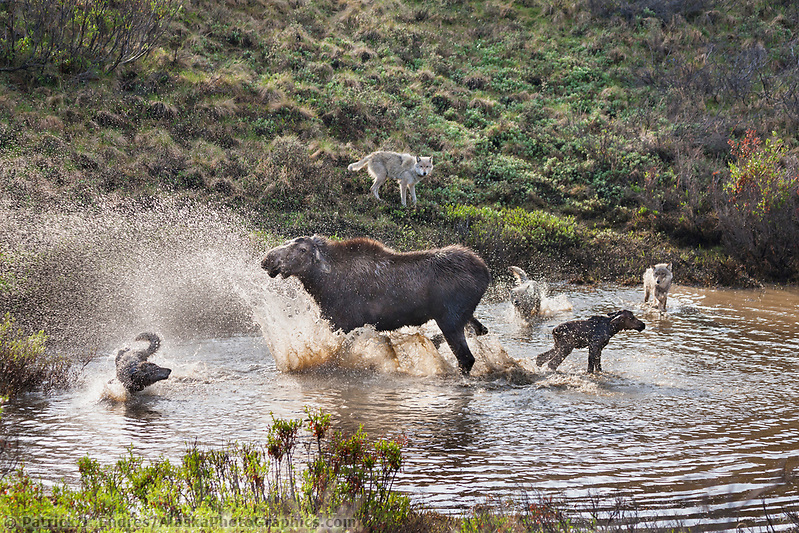
Cow moose defends her newly born calf from the Grant Creek wolf pack, who attack them in a small tundra pond, Denali National Park. In the end, the wolves got the baby moose. (Patrick J. Endres / AlaskaPhotoGraphics.com)
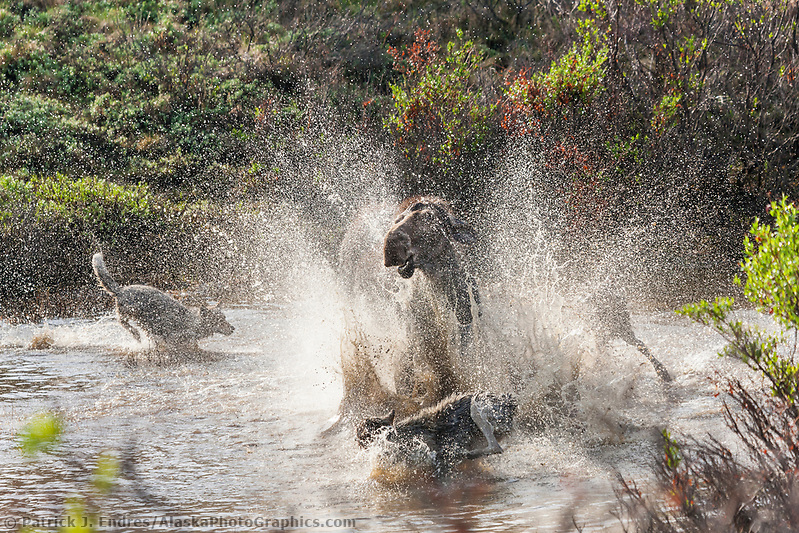
Cow moose defends her newly born calf from the Grant Creek wolf pack, who attack them in a small tundra pond, Denali National Park. In the end, the wolves got the baby moose. (Patrick J. Endres / AlaskaPhotoGraphics.com)
The Rut
Moose breed in late September and early October. During this period, called the “rut,” adult male bulls become protective of a collection of females and will challenge approaching bulls. They posture and joust by bringing their antlers together and pushing. While serious battles are rare, sometimes the challenges result in puncture wounds and occasionally death. The winner gets the mating rights to all the females. While photographing moose in Denali National Park during one excursion, I watched a challenge between two bulls develop into a full-blown fight. There were loud cracks of antler crashing, and one bull nearly lifted the other off the ground and knocked it over. The visible force, power, and sound were astounding. In the process, one bull moose broke a tine off his antlers!
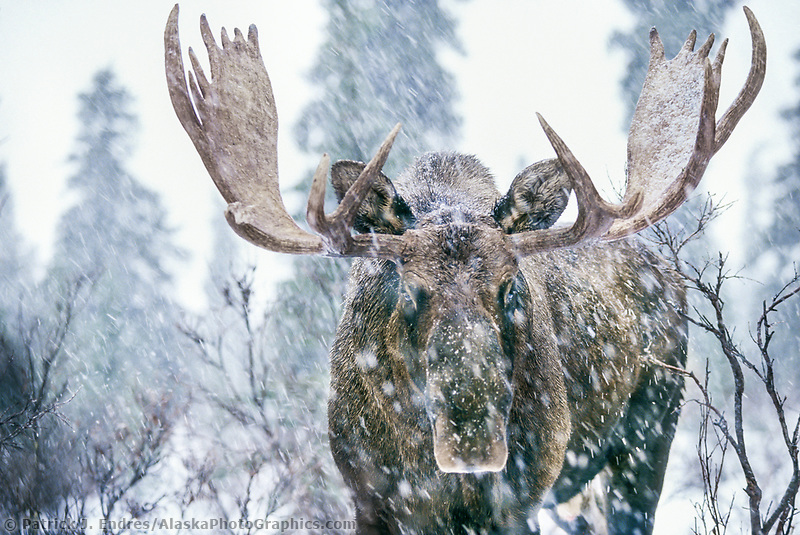
Bull moose in a snowstorm in the boreal forest of Denali National Park, Alaska. One tine is broken from a fight the day before. (Patrick J. Endres / AlaskaPhotoGraphics.com)
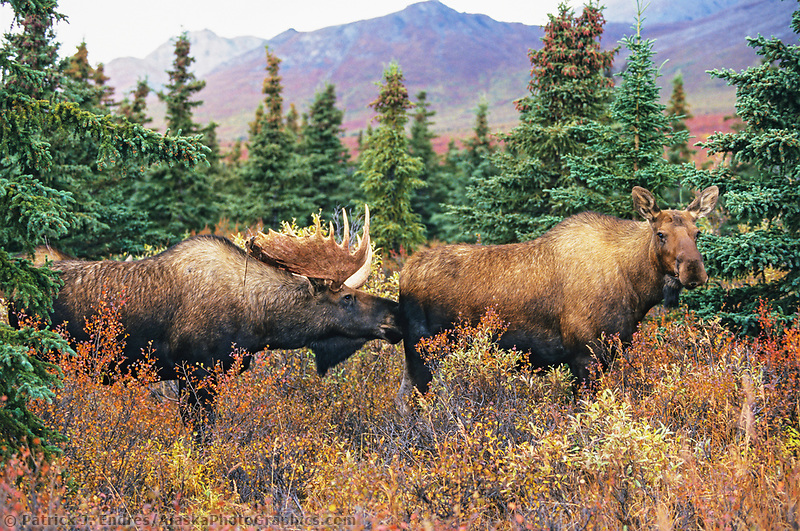
Bull Moose scents for cow’s readiness to mate dating the rut, Denali National Park, Alaska (Patrick J. Endres / AlaskaPhotoGraphics.com)
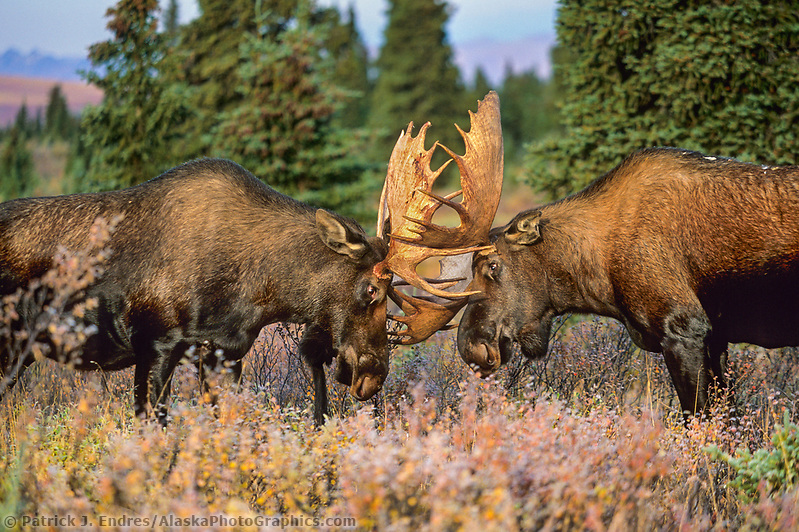
Bull Moose spar with antlers during the rut seasons in the boreal forest, Denali National Park, Alaska (Patrick J. Endres / AlaskaPhotoGraphics.com)
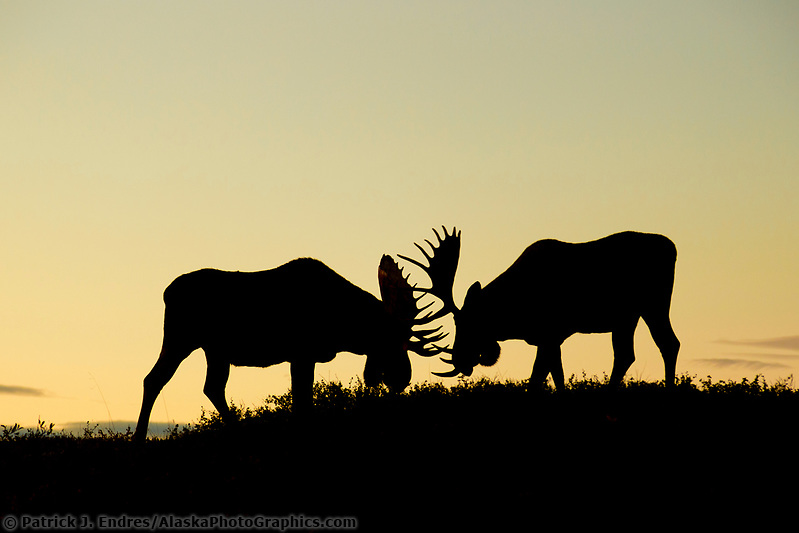
Bull moose spar in front of Mt. Denali, National Park, Alaska. (Patrick J Endres / AlaskaPhotoGraphics.com)
Giant Antlers
Bull moose grow new antlers yearly during spring and summer (females do not have antlers). They fall off after the rut during the winter months. It takes a lot of resources to grow this giant, bony headgear, which is covered with velvet nourished by a rich vascular network. The impressive racks can weigh up to 40 pounds. Once fully grown in August, moose shed the velvet by rubbing the antlers against bushes and trees. At this time, the antlers serve their primary purpose for the bulls as they compete for mating rights using their antlers as a weapon. Below is a large bull moose photo that reveals the biggest set of antlers I’ve ever seen on a moose.
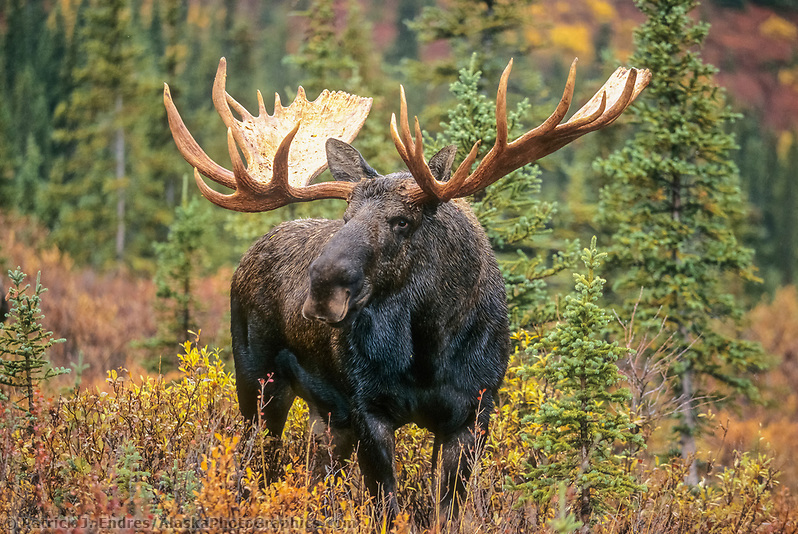
Large bull moose in the autumn taiga and boreal forest of Denali National Park, Alaska (Patrick J. Endres / AlaskaPhotoGraphics.com)
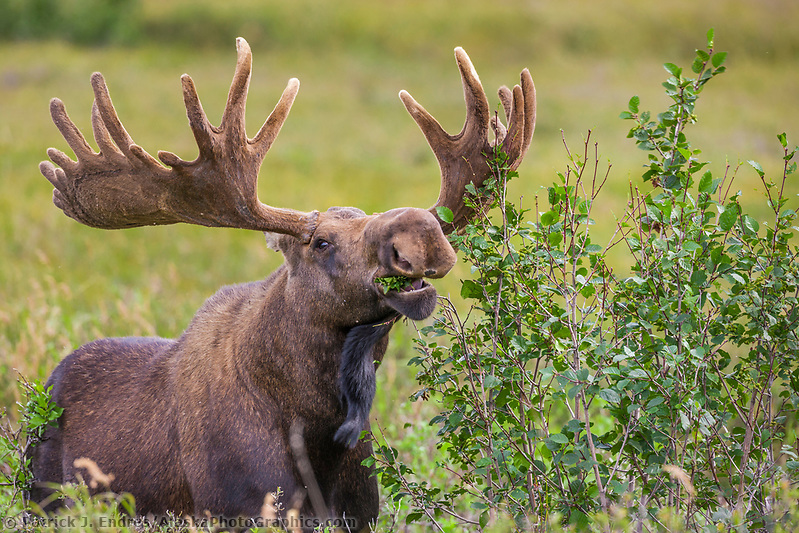
Bull moose feed to grow large antlers supplied by a vascular network of blood vessels under a velvet coating. Denali National Park, Alaska. (Patrick J Endres / AlaskaPhotoGraphics.com)
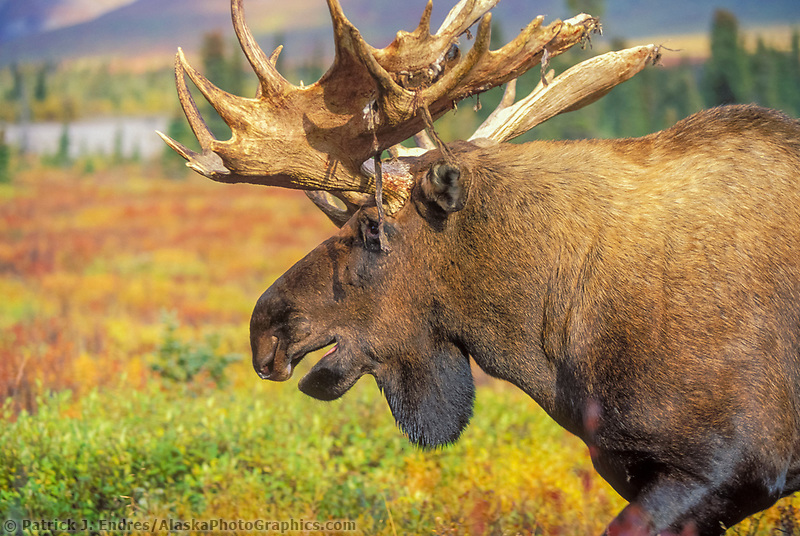
Bull Moose with antlers shedding on the colorful autumn tundra, Denali National Park, Alaska (Patrick J. Endres / AlaskaPhotoGraphics.com)
Food
During fall and winter, moose consume large quantities of willow, birch, and aspen twigs. Spring is the time of grazing as well as browsing. Moose eat various foods, particularly sedges, equisetum (horsetail), pondweeds, and grasses. During summer, moose feed on vegetation in shallow ponds and browse on birch, willow, and aspen leaves.
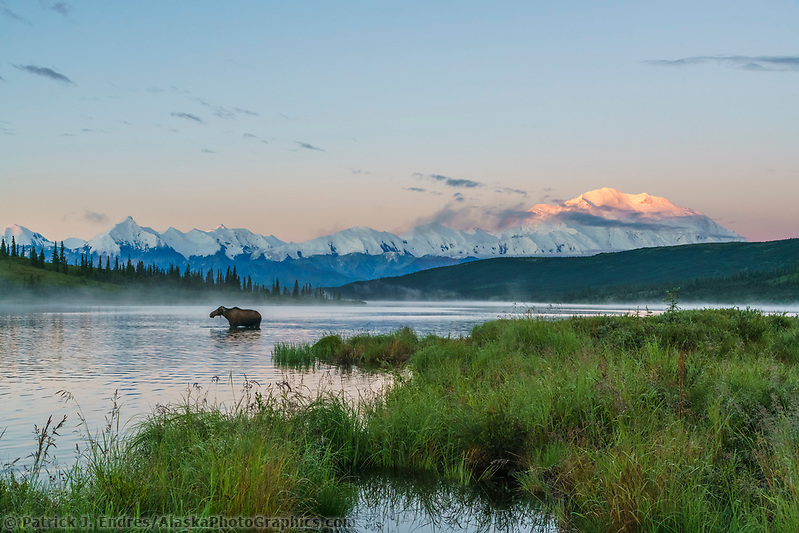
Sun rises on the summit of Denali, reflected in Wonder Lake, Denali National Park, Alaska. (Patrick J Endres / AlaskaPhotoGraphics.com)
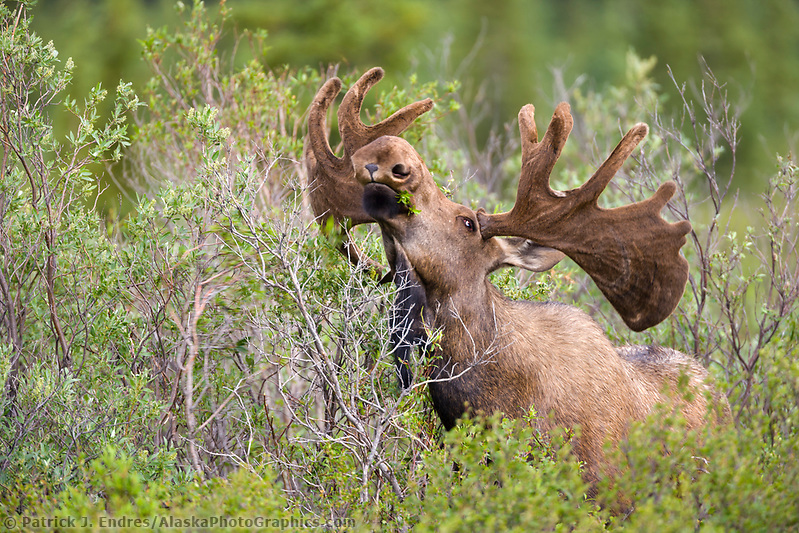
Bull moose feeds on willows in the tundra of Denali National Park, interior, Alaska. (Patrick J. Endres / AlaskaPhotoGraphics.com)
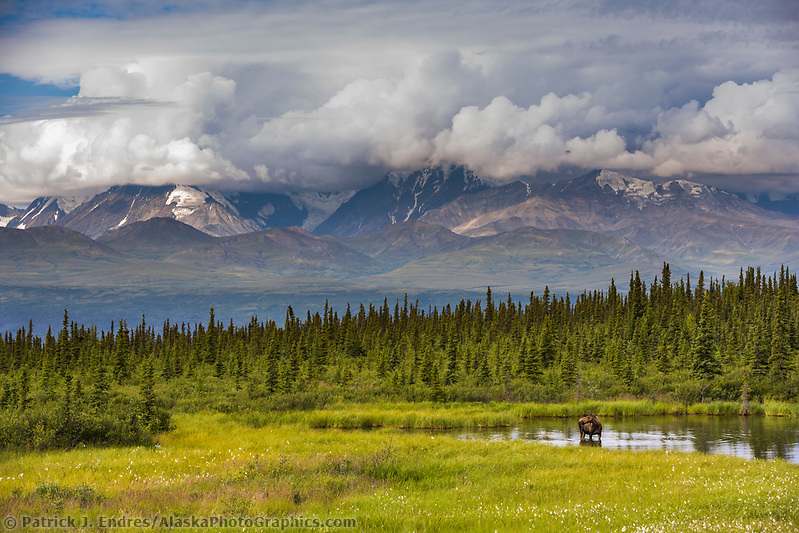
Cow moose stands in a tundra pond in the Alaska Range, Interior, Alaska. (Patrick J. Endres / AlaskaPhotoGraphics.com)
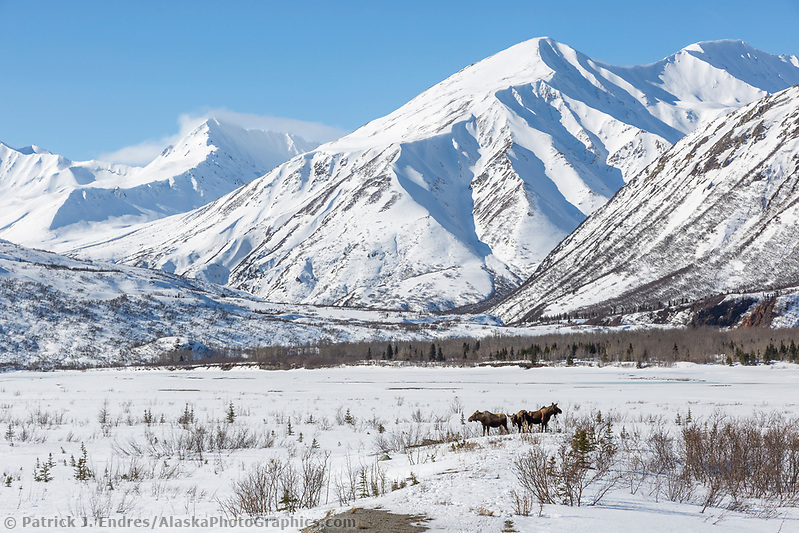
Cow moose and two calves are in the Alaska Range’s snow-covered mountains in Alaska’s Interior. (Patrick J Endres / AlaskaPhotoGraphics.com)
Moose and roads
Moose, roadways, and vehicles are not a good combination. Every year 700-800 hundred moose are killed by cars on Alaska’s road system. Unlike other members of the deer family, the eyes of a moose do not shine in the headlights, making them difficult to see in Alaska’s dark winter months. The Alaska Railroad system, which provides an area free of deep snow on the railroad tracks, can attract moose seeking more accessible travel. This results in numerous deaths of moose every year.
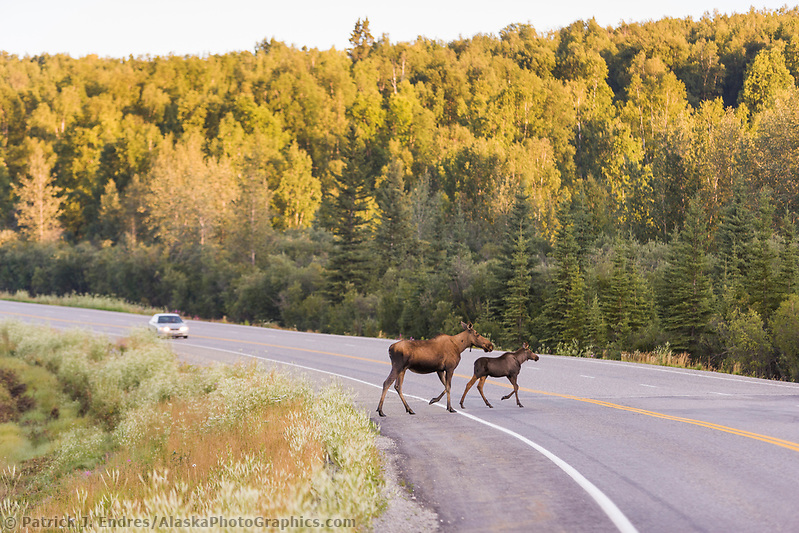
Cow and calf moose run across the Richardson Highway. (Patrick J. Endres / AlaskaPhotoGraphics.com)
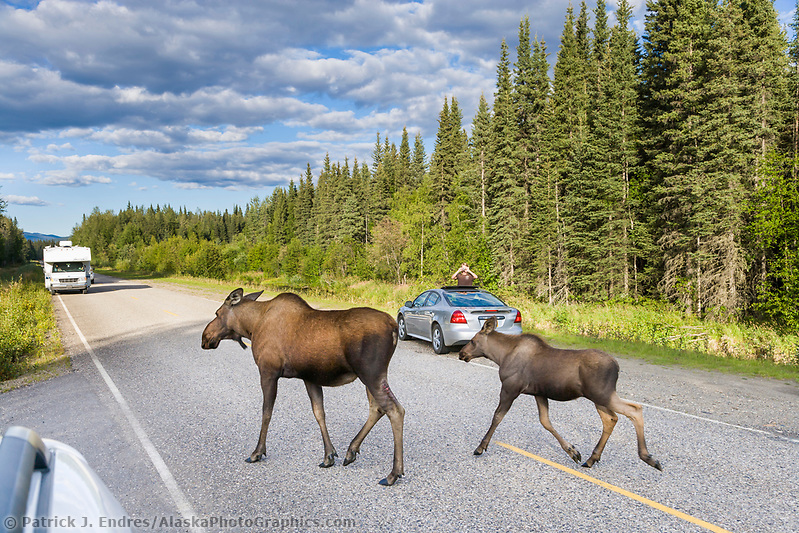
Tourists watch a cow and calf moose cross the Chena Hot Springs road, Interior, Alaska. (Patrick J. Endres / AlaskaPhotoGraphics.com)
Photographing Moose
Moose are generally docile animals, but like all wild animals, an appropriate and respectful distance should be maintained when photographing them. Many of the moose along the road corridor system of the state is accustomed to vehicle traffic, so as long as you stay inside your vehicle, you can get quite close and capture some great pictures. Beware of cows with young calves because they can protect their young. Do not approach closely. In Denali National Park, the moose show little fear of human presence since there has been no hunting pressure for an extended period. With appropriate telephoto lenses, one can successfully capture moose photos.
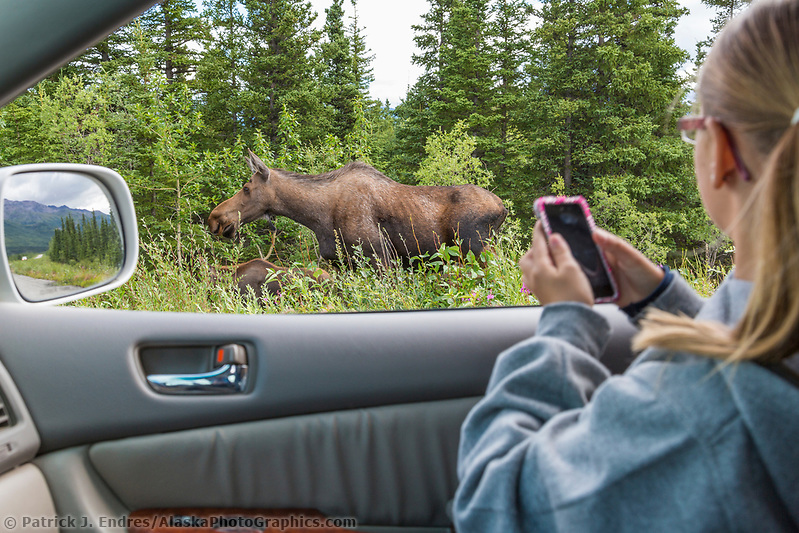
A young girl watches a cow moose browse on fireweed along the road in the Interior, Alaska. (Patrick J. Endres / AlaskaPhotoGraphics.com)
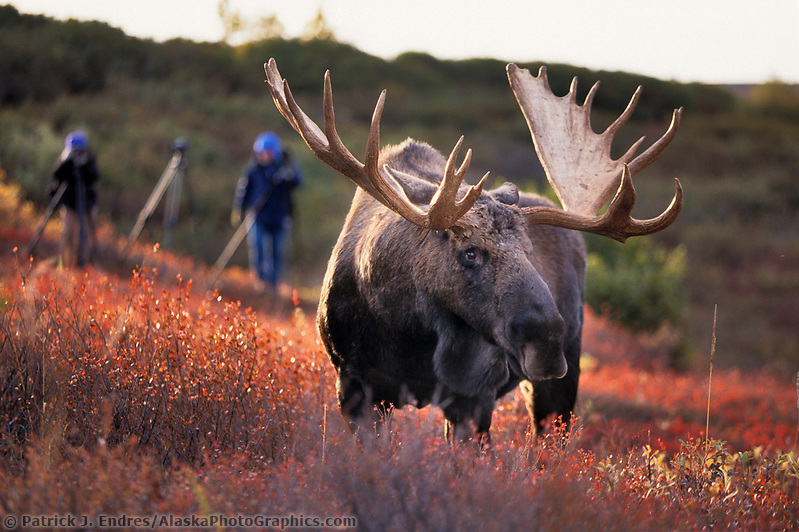
Photographers and large bull moose, autumn tundra, Denali National Park, Alaska (Patrick J. Endres / AlaskaPhotoGraphics.com)
